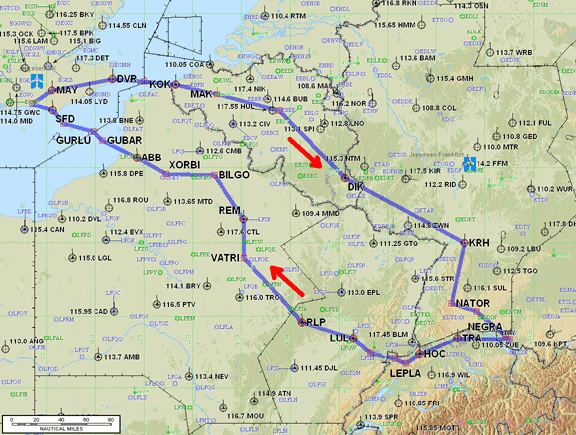
Trip to Friedrichshafen - April 2007
This article describes an IFR (airways) trip in a Socata TB20GT to the AERO 2007 show in southern Germany. The flight was uneventful and very pleasant; of approximately 3:20 duration each way.
Route Planning
The route has to be acceptable to the Eurocontrol CFMU route checker otherwise the IFR flight plan is likely to get rejected. There are several ways to do this, ranging from reading the standard route documents (SRDs), through various hacks, to filing something rough and leaving it to ATC to fix it up while hoping they won't chuck it out altogether. The system works for airlines but private pilots are out on their own. I always first try the amazing and free ASA autorouting website which was developed for deadly serious flight simulator users and is as unofficial as you can get but it's only a means to an end, and works most of the time. In many cases, the route needs to be manually iterated by excluding various conflicts that are reported at the bottom of the page, and re-routing. Edit 1/2010: most pilots now use this vastly better airway route generation tool: FlightPlanPro
The ASA site quickly came up with these two routes
EGKA DCT MAY R8 DVR L9 KONAN L607 GILOM M624 DIK M150 KRH N850 NATOR T733 USETI
T732 NEGRA DCT EDNY
(alternates EDDS, LSZR)
EDNY DCT TRA L856 HOC W102 LEPLA W110 LUMEL T10 TORPA V40 LUL G4 RLP B3 BILGO
H20 XORBI G40 ABB T27 GURLU Y8 WAFFU M605 SFD DCT EGKA
(alternate EGHH, EGMC)
By an amazing coincidence, both routes have the same length of 489nm, against a Great Circle distance of 428nm. This is a 14% excess; not unusual in Europe. Clearly, the system is not (yet) run by RyanAir.
Both routes passed CFMU in the FL140-FL160 area (though not much lower) and the normal objective, in an unpressurised aircraft carrying oxygen, is to ask for a "stop climb" once in clear VMC, to reduce the oxygen usage and (if non turbo engine) obtain a better speed. There are limits to this (airway MEAs, or crossing certain terminal areas) but generally ATC are happy to comply.
One cannot load a route with named airways into any GPS other than the most modern type, so one needs to translate these routes into the individual waypoints:
EGKA MAY DCR KONAN KOK MAK GILOM DIK KRH NATOR USETI NEGRA EDNY
EDNY TRA HOC LEPLA LUMEL TORPA LUL RLP VATRI REM BILGO XORBI ABB GUBAR GURLU WAFFU SFD EGKA
I use Jeppesen Flitestar for this; enter the CFMU-accepted airways route into the "plain text" route entry option and all the waypoints appear in the plog, together with their place names beloved by ATC to confuse pilots (e.g. KRH is a place called Karlsruhe).
There are occassions when the decomposed route has so many waypoints they don't fit into the GPS's memory (20 max in the KLN94) but in this case it was OK.
Flitestar does much more than this of course, but how much of the extra one uses varies according to preference. I carry a current IFR enroute chart but ensure it is rarely looked at, by printing out enroute map sections from Flitestar. If printed at 10 nm=1 inch scale, the airways intersection names are visible (usually!) and this is all one needs for enroute. I carry a tablet computer with Jeppview (which, basically, displays approach plates) but, never completely trusting electronics, I always print out the approach charts for the destination and alternate.
The flight plan was filed using the excellent Homebriefing service run by Vienna ATC which charges a flat rate Eur 36/year. With IFR flight plans, the acceptance/rejection usually comes back in under a minute, and the accepted flight plan gets transmitted to the enroute sectors within seconds.
AERO 2007 is a busy fly-in event and one has to book VFR and IFR departure and arrival slots. They can be booked 4 weeks in advance and the process is well organised, with website booking and Paypal payments available for the Eur 5.00 slot charge. It's advisable to book as early as possible as all slots seemed to have gone a week before the event. Hotels were also hard to get even weeks beforehand but we found some (pricey) rooms at the Krone hotel which is about 20 minutes by taxi.
For an IFR flight above FL095 the aircraft must be BRNAV equipped, and this is fulfilled by (and only by) an IFR certified GPS. In my case, it is the KLN94 with a KMD550 multifunction display. One could BRNAV certify an old KNS80 RNAV unit (fitted with antenna filters for the FM Immunity requirement) but ATC often give a DCT to a VOR which is 100-150nm away and this in fact happened a couple of times on this trip.
The weather was excellent and not a lot to write about:
EGKA 210655Z 210716 13006KT 9999 NSC TEMPO 0709 8000=
EDNY 210400Z 210413 04006KT CAVOK=
MSLP SigWx
The Flight
This was uneventful, in hazy but otherwise fine CAVOK conditions. We received a provisional departure clearance at Shoreham and called up London Control shortly after takeoff, when we received the usual rapid climb into controlled airspace. To save oxygen and get a slightly better TAS, I asked for a change in flight plan level from FL150 to FL090 and this was granted immediately. FL090 is above all the enroute MEAs and was maintained for the entire route.
The route flown was essentially as filed but with several shortcuts given by ATC. However, the most obvious shortcut (cutting out the KRH corner) was not granted despite several requests. Presumably, German ATC are unable to talk to French ATC.
We saw only one other light aircraft on the entire route and that was near the destination.
I had booked an IFR slot and arrival was a radar vectored ILS via Zurich radar. The approach would have offered beautiful views if it was not for the haze. The following picture was taken after departure; sharp readers will realise it looks wrong for a 3 degree ILS:
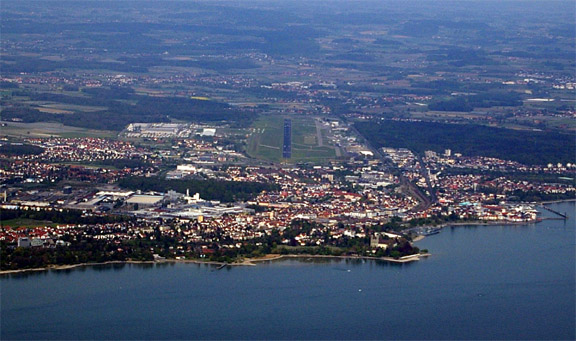
The top tip in flying is to never leave the aircraft until avgas has been delivered and this is as true at AERO as at some Greek island. We didn’t do it and had to get the shuttle bus all the way back to the aircraft, wasting a couple of hours.
AERO 2007
This is a huge general aviation exhibition, far bigger than anything seen in the UK and covering all aircraft types short of large transport jets. There were some aerial displays too but in my view once you have seen one you have seen them all.
The immediate observation is that most new GA activity is taking place in two areas:
(a) light aircraft in what is variously called “sports”, “ultralight”, “permit” etc categories, and
(b) pressurised turboprops and jets with 7-digit (and above) price tags.
All the aviation regulators should be sent (on an all expenses paid trip, of
course) to this show to see for themselves how successfully they have throttled
activity in the certified light GA arena! The usual players (Cirrus,
Cessna, Piper, Mooney) were there alongside a few half baked newcomers like
the Czech-made Evektor Cobra

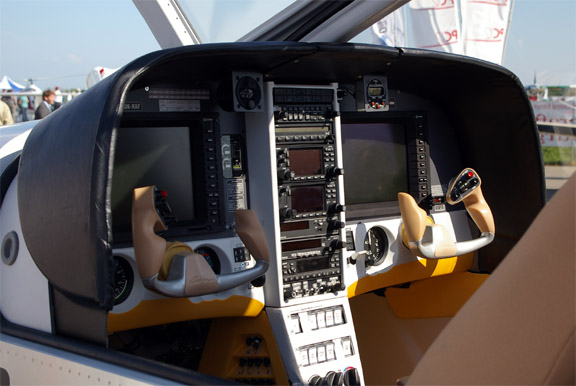
but clearly innovation in this market moves at snail’s pace, presumably because almost nobody in Europe is buying IFR machinery in the sub-$1M bracket. Total Cirrus SR20/SR22 sales in Europe are only 100-150 to date but they are busy cleaning up the USA. Glass cockpits (Garmin 1000 usually) were universal on all IFR aircraft, regardless of how tacky the finished panel looked.
Huge hangars were dedicated to ultralights, where the Czechs are particularly busy. Nearly all these types are limited to VFR by law but looking at the performance and equipment in many of them it’s easy to guess where they will be flying under "VFR"…

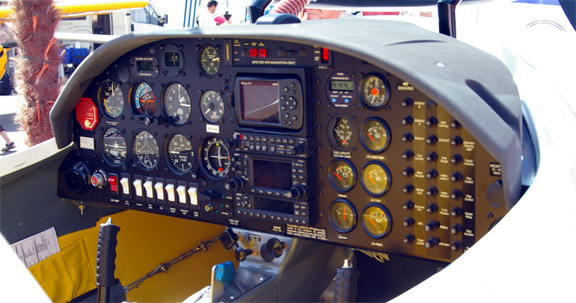
Another hangar was full of machines best described as a parachute with a lawn mower on the back of it, but it shows how diverse the aviation scene can be - so long as regulation is appropriate to the risk to the public.
There was a great deal of new avionics on show, mostly uncertified glass panels for the "sports" market. Universally, these use the recently introduced solid state gyros, and with the connection of pitot and static sources you also get an altitude and TAS display. These low cost products are as good as a G1000 (minus the GPS, etc) but will probably never appear on certified aircraft; I spoke to several of the vendors and they have little interest in pursuing that market when they can sell immediately to the other one.
One of the most interesting developments was a Wankel rotary engine, 300HP, from Mistral. This has IO-540 compatible mountings and is a realistic replacement for the old Lycoming. They claim the specific fuel consumption is same as the IO-540, and that an avtur version is also feasible which would be even more amazing.
The turboprop and jet markets were well represented as one would expect, with Piper (Meridian, Jetprop), Socata (TBM850), and the light jets.
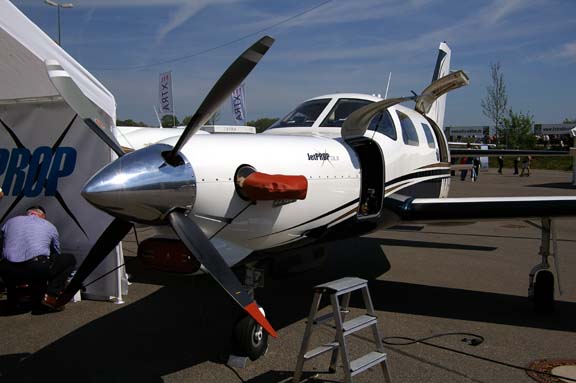
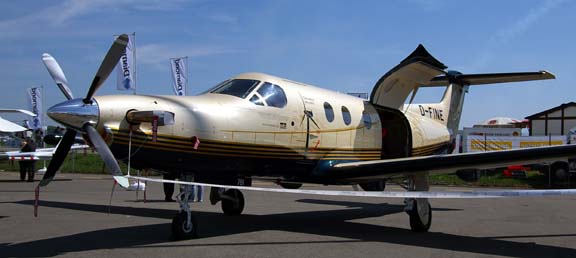
Eclipse were present with a real aircraft but suprisingly the Diamond D-jet was a mock-up. It was difficult to get near these, presumably because priority was given to looking after potential customers. There were also a number of not so light jets:
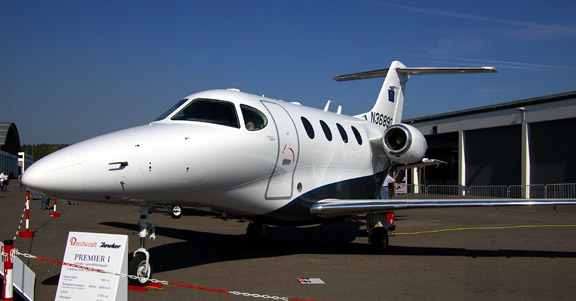
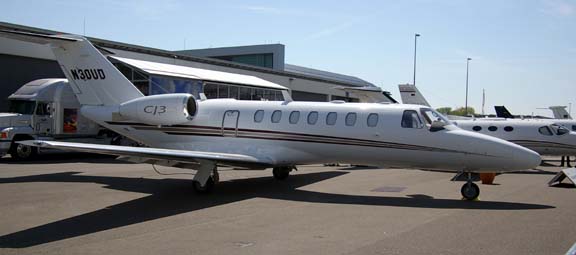
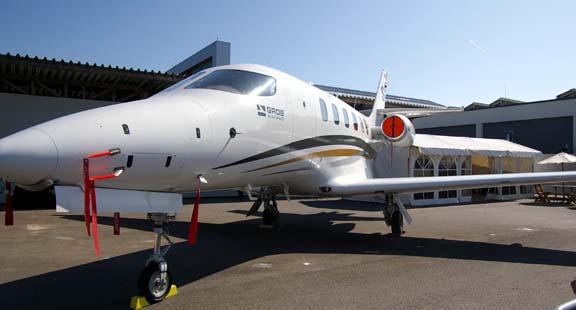
Return Flight
The weather was exceptionally good: MSLP charts 1200 1800 TAFs.
With hundreds of aircraft departing at more or less the same time, the departure was extremely busy and it was hard to get a word in edgeways. We managed to get the departure clearance eventually and about half an hour after starting up were airborne.
The flight was uneventful. The departure clearance referenced a SID but control was taken over by Zurich radar within a few miles, and followed the filed route with a few minor shortcuts. We asked, and were granted, a reduction in the flight planned level to FL100 but climbed to FL110 and then FL120 to get above some scattered cloud, to descend back to FL100 later.
To the south we could see the Swiss Alps but there was a lot of haze
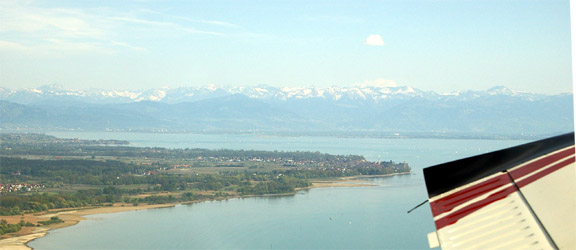
Back in UK airspace, London Control gave us a “direct Shoreham” at the FIR boundary and a descent out of controlled airspace shortly afterwards. No other light aircraft were seen on the route but I later heard from a friend who heard me on the radio in his 421C, near Zurich. Airways GA is a very small world!
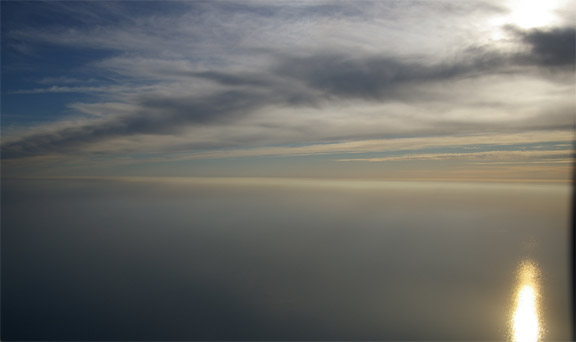
Approach into Shoreham was under VFR as there was little point in flying an instrument approach in such unchallenging weather.
Given the excellent weather, this trip could have been easily done wholly under
VFR, either at low level (underneath controlled airspace) or higher up and with
transits where available. However, the weather is rarely this good and the slots
had to be booked weeks beforehand. RyanAir fly to EDNY but that involves a trip
to Stansted and half a day spent messing about having one's shoes checked for
explosives.
Last edited 11th January 2010
Any feedback, reports of dead links, corrections or suggestions much appreciated:
Contact details
Pilot: UK PPL, FAA CPL/IR, 750hrs TT at the time.
Aircraft: N-reg Socata TB20GT